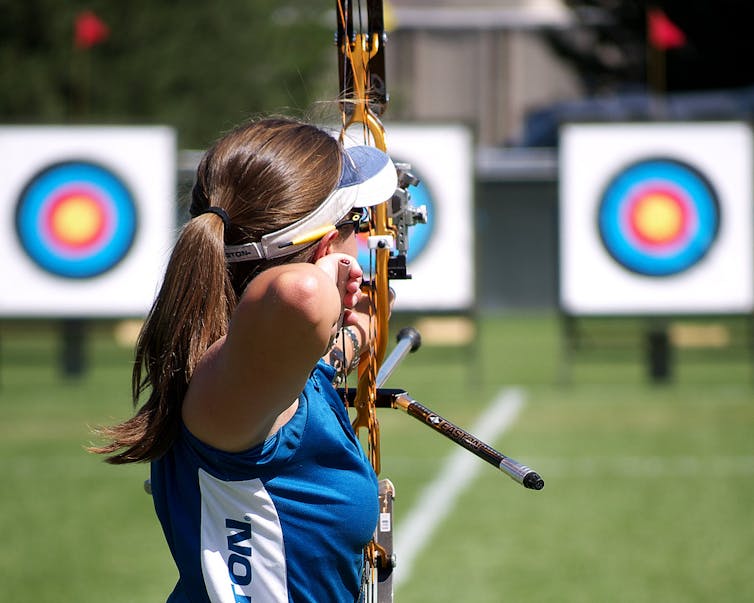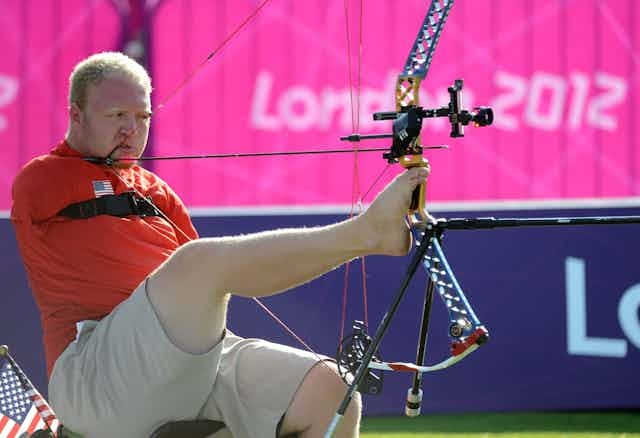The accuracy obtained by top-level archers – at both the Olympics and Paralympics – using modern archery equipment would astonish most non-archers. Archers stand or sit 70m away from a target which has a centre scoring ring (the “ten ring”) just 12.2cm wide.
In a major competition such as the Paralympics, the Olympics or the World Championships, an archer using a recurve bow needs to hit that ten ring roughly once every two shots in order to be competitive.
With the more technically sophisticated compound bow (using eccentric pulleys to modify the bow’s draw force) an archer needs to hit the centre ring at least twice out of every three shots. And, they need to do so even when it is windy and the arrows are being blown around.
Most non-archers will not be able to keep a pointer at arm’s length aligned with the centre ring of that target at that distance, let alone having to do so when holding the substantial draw force and mass weight of the bow. It’s hard work!
Major archery competitions are decided by very small margins. Often it is only a single point in several hundred points that matters. If we can cleverly select and optimise the archer’s equipment, we can obtain a small score advantage which might provide a considerable competitive bonus.
We could do this through trial and error. But it’s far more effective and satisfying to use mathematical models of the equipment. Developing and testing those models has been the subject of research carried out in the Department of Mechanical and Aerospace Engineering at Monash University.

Blowin’ in the wind
The thing that messes most with an outdoor archer’s score is wind drift. If an archer is 70m from the target, a moderate breeze can easily move the arrow by several target rings.
Where possible the archer tries to shoot between wind gusts. But because there is a time limit for each group of six shots, it is inevitable that the archer will need to sometimes shoot in strong wind.
The archer usually sets the bow’s sight for the average wind drift and then aims off the centre of the target for each shot. They judge the offset depending on the wind strength and direction before the shot, and using knowledge from the movement seen for past shots. It’s an error-prone approach.
But if the effect of wind on the arrow can be reduced, it also reduces the error.
The wind drift is directly related to the aerodynamic drag of the arrow. Understanding the various components of the drag and minimising each of them will help. Drag affects the arrow point, the arrow shaft, the arrow’s fletches, and the arrow’s nock (which attaches the arrow to the bow string). Of those, for a typical arrow, the shaft drag dominates - it contributes approximately 74%. The fletches contribute 13%, the nock 9% and the point 4%.
Don’t be a drag
The shaft drag is primarily due to the shaft’s comparatively large surface area. It can be minimised by using a shaft of small diameter. Most competition arrows are constructed from carbon fibre composite material with a minimum diameter of approximately 5mm.
The fletch drag is due to both their surface area and to their projected edge frontal area. The fletch area needs to be big enough to stabilise the arrow (stability is primarily obtained through the lift from the fletches rather than drag). Given a certain fletch area it is then best to use a low profile in order to minimise the pressure drag from the edge projected area.

In order to overcome small imperfections in the arrow (such as an arrow that’s not quite straight) it is best to angle the fletches to spin the arrow about its longitudinal (length-ways) axis. This costs a small amount of drag while the arrows gets up to its full spin rate. Once spinning, the fletches are effectively edged on to the wind. To further minimise the pressure drag it is desirable to use a very thin fletch.
Drag from the arrow’s nock is primarily due to pressure drag from the wake – the area of turbulence left behind as the arrow speeds through the air. It is best to select a nock with a small diameter. The nock has to fit on the string, which means the choice of shape is a bit limited, but it should have at least some degree of aerodynamic shaping to reduce its drag.
In most cases the arrow’s point is only a small contributor to the drag. A typical “bullet shaped” point is pretty streamlined.
By carefully optimising each of the portions of the arrow, we think we can give an archer a 5% wind drift advantage over their competitors. It’s little, but it goes a long way.
But even the best technology won’t save a bad shot. We can help, but the archer still needs to shoot well and to deal with the considerable pressures of top-level competition.

